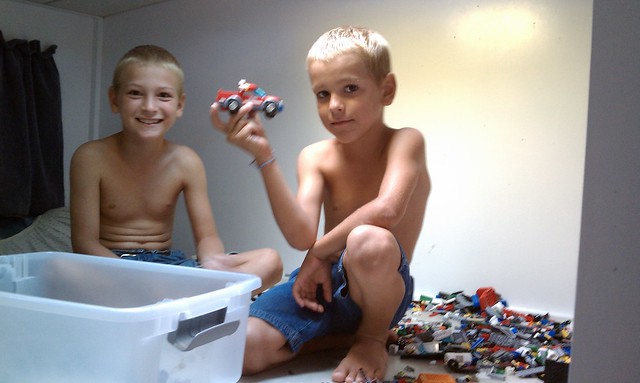If you have spent any time at all reading cruising magazines or looking at other boating family blogs, you by now realize that Lego bricks are the ultimate toy for children on boats. They are among the best toys for any child anywhere, but because of their compact size and endless creative possibilities, they provide hours of entertainment and exercise for small brains in the confining space of a boat. For rainy days and weekends they are indispensible. Our kids, if they had to pick one thing to take with them to a desert island, probably even before food, would pack the Lego bin.
My brother loved his Lego toys as a kid, too. Actually, he still loves his Lego collection, which is much improved and expanded. He sometimes even shares it with his four boys. Our boys’ collection, seen below, is quite small compared to the cousins,’ and it exists in a state of chaos. With a collection the size of my brother’s, a bin and a pile would be preposterous. Plus, they have two smaller kids that would be forever eating or choking on them. So they came up with this ingenious solution for organizing Lego and making playtime more productive and less frustrating. It worked so well, my brother decided to build and sell his sorting cabinet/building tables through a terrific website, BrikCrate.com.
He generously offered to build our boys a crate to mount in their cabin, but upon further reflection our boys looked at the trade-offs and decided against it. The two options are: find all your pieces easily and build quickly, then re-sort to clean up, which can be slow and laborious; or build slowly, searching for pieces in a pile, and clean up quickly with a dustpan for a shovel. Because our boys’ play space is also their sleeping space (they inflate/deflate their air bed depending on how they want to use the space), they opted for quick cleanup. This choice is not without cost. They are forever losing pieces; sometimes they fall out of the bed and roll into the bilge. And it can take all day to plan a project, search for the right pieces and build something. At least the collection is out of the way, either locked in the bin or up in their berth out of the reach of small children. But for other boat families, a BrikCrate might make a Lego collection easier to manage.
For families with a large or sprawling collection, a BrikCrate is an ideal solution. Each cabinet is hand-made of solid wood in my brother’s workshop and comes with drawers and customized labels. The cabinet has a hinged cover that folds down to become a table top with a locking support leg. The stools for sitting at the table also serve as storage for road plates or large pieces that don’t fit in the cabinet. While the crate may seem expensive, considering the price of electronic toys that turn kids’ brains to oatmeal, and how much more valuable an organized Lego collection is made, the price is well worth it. And for families with small siblings, the crate protects pieces and projects from grabby toddlers as well as protecting crawling infants from choking hazards.
This may seem a shameless bit of nepotism, but it’s actually a fantastic product, and considering how long Lego has been around, I can’t believe no one has thought of it before. In any case, you might like the website. In his “links” link he’s got a great stop-action film he made with Lego bricks and a web cam. Check it out at www.brikcrate.com.

